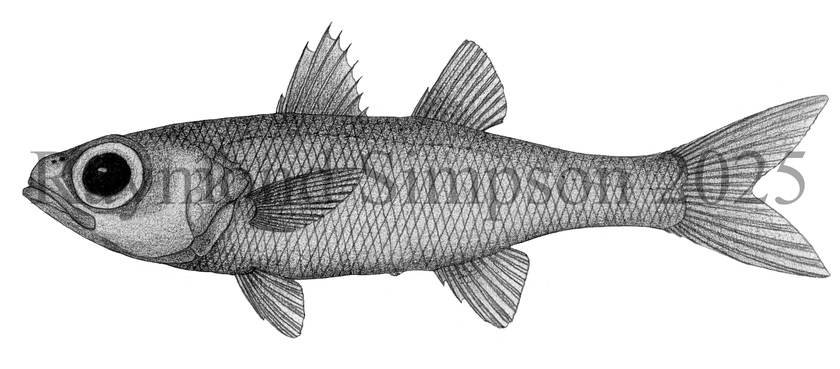
Common Name
Black Deepsea Cardinalfish
Year Described
Risso, 1810
Identification
Dorsal Fin: VII-VIII-1, 10 (rarely 9 or 11)
Anal Fin: II, 9
Pectoral Fin: 19-23
Lateral Line: 46-50
Gill Rakers: 23-26 (first arch)
Vertebrae: 11+14 = 25 total
Body moderately slender and laterally compressed. Large terminal mouth. Teeth conical. Lingual and endopterygoid teeth absent. No enlarged teeth present at lower jaw symphysis. Maxillary process absent. Opercular spine absent. Opercular margin with spinelets. Pyloric caeca 21-34. First dorsal spine small (less than half length of second). Eighth dorsal spine reduced and separated from rest of fin. Ribs present on last abdominal vertebrae. Body scales deciduous and ctenoid. Lateral line complete and composed of pored scales. No luminous organ on belly.
Color
Body black to dark purple-gray, with a purple or blue sheen. Paler on belly. Often silvery on flanks and opercle. Largest fish dark overall. Inside of mouth and gill cover black. Eye black.
Size
Maximum size to over 550mm SL. By far the largest species of the genus in the Atlantic.
Habitat
Known from 75-1200m, but most common between 300-800m. Adults benthic but juveniles pelagic.
Range
Known from scattered records off New England, the Gulf of Mexico, and off S. Brazil. Much more common in the eastern Atlantic.
References
Mayer, G. F. 1974. A revision of the cardinalfish genus Epigonus (Perciformes, Apogonidae), with descriptions of two new species. Bulletin of the Museum of Comparative Zoology v. 146 (no. 3): 147-203.
Other Notes
Unique in the genus in having eight dorsal fin spines, a high number of pyloric caeca, and a large maximum size. Poorly known in the western Atlantic but common in the eastern Atlantic.